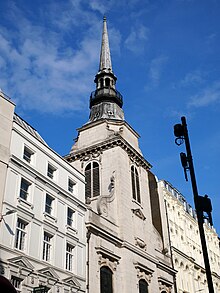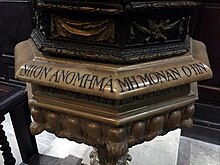St Martin, Ludgate
| St. Martin, Ludgate | |
|---|---|
 St Martin, Ludgate (withSt Paul'sin the background, right) | |
 | |
| Location | London,EC4 |
| Country | United Kingdom |
| Denomination | Church of England |
| Previous denomination | Roman Catholic |
| Architecture | |
| Heritage designation | Grade Ilisted building |
| Architect(s) | SirChristopher Wren |
| Style | Baroque |
| Administration | |
| Diocese | London |
St Martin, Ludgate,also known asSt Martin within Ludgate,is anAnglicanchurch onLudgate Hillin the ward of Farringdon, in theCity of London.The church is of medieval origin, but the present building dates from 1677 to 1684 and was designed by SirChristopher Wren.[1]
History[edit]
Some legends connect the church with legendary King Cadwallo (now usually referred to asCadwallon ap Cadfan,father ofCadwaladr.A sign on the front of the church reads "Cadwallo King of the Britons is said to have been buried here in 677". Modern historians would place his death about 682. Cadwallo's image was allegedly placed onLudgate,to frighten away the Saxons. However, Middlesex and the London area were controlled by the Anglo-Saxon polities at that time and there is no evidence of British or any other occupation of the intramural area of the abandoned 'Londinium' since the late fourth century. Previously the sign stated that it was the West Saxon kingCaedwallabut this was contradicted byBede's writings that he was buried in Rome.[2]However the earliest written reference is from 1174. A Blackfriars monastery was built nearby in 1278. The church was rebuilt in 1437 and the tower was struck by lightning in 1561. The parish books start from 1410. Before theReformation,the church was under the control ofWestminster Abbey,and afterwards underSt. Paul's Cathedral.


St Martin of Toursis aPatron Saintof travellers. Churches which are dedicated to him often stand just within city gates. A blue plaque next to church records the earlier presence of Ludgate, demolished 1760. The church consists of a lead-clad dome, topped by a lantern and on top of that a sharp obelisk steeple.[3]From the lower part ofFleet Streetthe steeple stands between the viewer and the dome ofSt Paul's Cathedral.Wren probably planned to make a contrast between the spiky steeple of St Martin's and the circular dome of St Paul's.[4]

In "The Roaring Girl, or Moll Cutpurse" by Dekker and Middleton, Sebastian says "The clock at Ludgate, sir, it ne'er goes true". This might refer to St Martin's church. "I owe you three farthings, say the bells of St Martin", might refer to this church, but is more likely to refer toSt Martin Orgarin Cannon Street (previously Eastcheap). In 1614Samuel Purchas,a travel writer, became the rector. On the 17th century font there is aGreekpalindrome– ΝΙΨΟΝ ΑΝΟΜΗΜΑΤΑ ΜΗ ΜΟΝΑΝ ΟΨΙΝNipson anomemata me monan opsin(Wash the sins, not only the face). There is a 17th-century carved oak double churchwarden's chair[5]– the only one of its kind known to exist. The north windows are byPowell of Whitefriars,representing the Abbot and Chapter of Westminster, the Bishop of London, and the Dean of St Pauls. Those high up on the south are also by Powell.
The medieval church was repaired in 1623, only to be destroyed in theGreat Fire of Londonin 1666.[6]Rebuilding was not immediate, but was largely completed by 1680, finished in 1703. In 1669 aRoman tombstone,now in theAshmolean Museum,was found.[7][8]The current design is topped by a lead-covered octagonal cupola supporting a balcony and tapered spire rising to a height of 158 ft (48 m). The centre of the church is in the form of aGreek cross,with four large columns. The chandelier dates from about 1777 and comes from St Vincent's Cathedral in theWest Indies.As a curiosity, this is from the burial register: "“1615, February 28, St. Martin’s, Ludgate, was buried an anatomy from the College of Physicians.” (It was first noticed by Andrew Lang, in an article in "Books and Bookmen" ). TheRoyal College of Physicianswere based inAmen Corner,a few yards away from 1614 to 1666.[9]In 1678Robert Hookedesigned a new hall in Warwick Lane, also nearby.
The view from the steeple towards the river is spectacular. It was painted by T.M. Baynes.
In 1893 to 1894, the church underwent a major rebuilding and alteration, with the floor level raised, and many bodies disinterred from the churchyard and reburied atBrookwood Cemetery.[10]
In 1941, during theLondon Blitz,a Germanincendiary bombdamaged the roof, but St Martin's received relatively little damage during theSecond World War.In 1954 St Martin's became aGuild Churchand was designated a Grade Ilisted buildingon 4 January 1950.[11]
Organ[edit]

The organ is a Bernard Schmidt design dating from 1684.[12]There are carvings byGrinling Gibbonsinside.[13]The contemporary carvings in the church are also attributed to three joiners, Athew, Draper and Poulden, and to the carvers Cooper andWilliam Newman.[14]There are organ recitals every other Monday;chamber musicevery Wednesday and Friday.
A specification of the organ can be found on theNational Pipe Organ Register.[15]
Past organists at St Martin include:
- Frederick Albert Bridge(b. 1841 – d. 1917)
See also[edit]
Notes[edit]
- ^"The London Encyclopaedia" Hibbert, C.; Weinreb, D.; Keay, J.: London, Pan Macmillan, 1983 (rev 1993, 2008)ISBN978-1-4050-4924-5
- ^Tony Sharp: The Farringdon Wards of the City of London a... History p59
- ^"The City of London Churches"Betjeman,JAndover, Pikin, 1967ISBN0-85372-112-2
- ^"The Old Churches of London" Cobb,G: London, Batsford, 1942
- ^"London:the City Churches” Pevsner,N/Bradley,S New Haven, Yale, 1998ISBN0-300-09655-0
- ^"The City Churches" Tabor, M. p83:London; The Swarthmore Press Ltd; 1917
- ^RIB 17. Funerary inscription for Vivius Marcianus
- ^"The City of London Churches: monuments of another age" Quantrill, E; Quantrill, M p72: London; Quartet; 1975
- ^Mentioned in Pepys Diary "Samuel Pepys – The Shorter Pepys" Latham,R(Ed) p484: Harmondsworth,1985ISBN0-14-009418-0
- ^"The Brookwood Necroplois Railway" Clarke,J.M: Oasdale, Usk, 2006ISBN978-0-85361-655-9
- ^Historic England."Church of St Martin (1359194)".National Heritage List for England.Retrieved23 January2009.
- ^Pearce,C.W. “Notes on Old City Churches: their organs, organists and musical associations” London, Winthrop Rogers Ltd 1909
- ^"The Visitors Guide to the City of London Churches" Tucker,T: London, Friends of the City Churches, 2006ISBN0-9553945-0-3
- ^Bradley and Pevsner,London: The City Churches,p. 103.
- ^"NPOR [N01538]".National Pipe Organ Register.British Institute of Organ Studies.Retrieved8 July2020.
External links[edit]
- Christopher Wren church buildings in London
- Churches completed in 1684
- 17th-century Church of England church buildings
- English Baroque church buildings
- Church of England church buildings in the City of London
- Grade I listed churches in the City of London
- Rebuilt churches in the United Kingdom
- Diocese of London
- 1684 establishments in England
- Ewan Christian buildings
